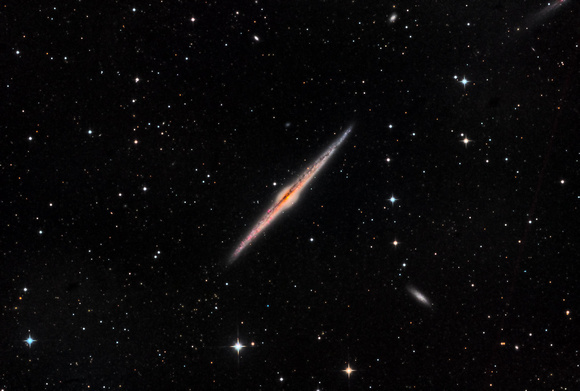NGC4565 - The Needle Galaxy
NGC4565 - (Sliver) Needle Galaxy Apr 2022
Planewave CDK 12.5 - AIS6200MM
A-P 1100 GTO AE, Antlia Pro LRGB filters & Antlia 3nm Ha Pro
L (30 x 180s exposures, Gain 0, Bin1x1)
L (26 x 60s exposures, Gain 100, Bin 2x2)
RGB (4 x 26 x 80s exposures, Gain 100, Bin 2x2)
Ha (12 x 900x exposures, Gain 100, Bin 2x2)
Total integration time = 6.7 hours over 3 (meh transparency) nights
NGC4565 presents an edge on view of a spiral galaxy at a very acute angle to the spiral arms, which cut almost directly in front of the core. The dust in the arms give the red/orange hue to the elliptical shaped core, with the very centre just peaking below. Due to the angle, it is we are barely able to pick out individual dust lanes in the spiral. The LRGB image was enhanced with additional Ha filtered frames as I was curious where star forming regions. (These Ha frames were used to enhance the lum, red, and a little bit of blue channels, and the star forming hydrogen appears as pink areas). Curiously, only the lower left side of the spiral shows such areas while there are none visible on the upper right. I believe this is indicating the direction of the spiral, with the upper right being the leading edge of the spirals (no Ha visible) and the lower left being the trailing edge.
Processing ended up being a exercise in gradient removal due to a big bright moon on a two of the nights with lots of moisture in the air to scatter the moonlight and poor transparency. To remove gradients, I ended up using the "Normalized Scale Gradient (NSG)" script after trying the native "Adaptive Normalization (AN)" in Pixinsight. Not for the first time, AN produces a halo around the galaxy. Around the galaxy was dark, but further away a "halo" appeared which then disappeared again further afield.
I have written elsewhere on how much I dislike spline fits, because they are anathema to economicsts, scientists, and engineers. Some like them because they "exactly" fit all the data - assuming they are infinitely accurate and precise. In doing so, they overshoot and create non-physcial artifacts, such as the halo I described above. AN, you guessed it employs such a spline. NSG, exploys a different form of fit to the gradient that allows you to control how precisely the model fits the image - enabling one to control or eliminate such an effect. Note that "local normalization" wasn't tried, but it should work as well, because it doesn't employ the dreaded splines. Dynamic background extraction (DBE) also employs splines so one must be careful with the tolerance here too - but if a data point doesnt fit here, it doesnt use it.
In many cases, AN does work fine, but splines are often awful - if you are an Excel user - done USE THEM. Other than video games, where physicality doesn't matter, they can do very bad things.
(although the also native "local normalization" wasn't tried, but I am pretty
THe other thing of note, is that I used "Lightroom" to polish the image after Pixinsight.


